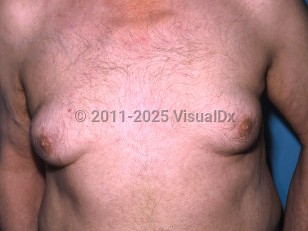Gynecomastia
Alerts and Notices
Important News & Links
Synopsis

Gynecomastia can be caused by medications or exposure to exogenous chemicals. When gynecomastia is related to medication use, the mechanism for the excessive breast tissue development is an impaired balance in the serum estrogen to serum androgen ratio, or a rise in prolactin level.
Medications with strong evidence supporting an association with gynecomastia include antiandrogens, sex hormones, spironolactone, cimetidine, verapamil, and chemotherapy (especially alkylating agents). Tricyclic antidepressants, neuroleptics, calcium channel blockers, omeprazole, sulpiride, captopril, digitalis glycosides, and some antibiotics and growth hormones have also been reported. Once the offending medication is removed, the gynecomastia will usually resolve.
Physiologic gynecomastia typically occurs during 3 phases of life: shortly after birth, puberty, and older age (60 years and older). It can occur shortly after birth due to increased fetal blood levels of estradiol and progesterone that stimulate newborn breast tissue. During puberty, the increased gonadotrophins and testosterone levels can cause gynecomastia, which typically self-resolves within 3 years.
Pathologic gynecomastia is caused by increased estrogen-to-androgen ratio either in circulation or in breast tissue. Testicular tumors, such as Leydig cell tumors, Sertoli cell tumors, and granulosa cell tumors are estrogen-secreting tumors that increase estrogen levels. Besides increased estrogen production, lower testosterone levels can also increase estrogen-to-androgen ratio, which causes gynecomastia. For example, primary hypogonadism, Klinefelter syndrome, Kallmann syndrome, and Kennedy disease are associated with an increased estrogen-to-androgen ratio.
Codes
N62 – Hypertrophy of breast
SNOMEDCT:
4754008 – Gynecomastia
Look For
Subscription Required
Diagnostic Pearls
Subscription Required
Differential Diagnosis & Pitfalls

Subscription Required
Best Tests
Subscription Required
Management Pearls
Subscription Required
Therapy
Subscription Required
Drug Reaction Data
Subscription Required
References
Subscription Required
Last Updated:11/30/2023

